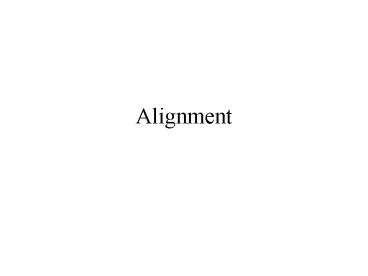Alignment PowerPoint PPT Presentation
1 / 20
Title: Alignment
1
Alignment
2
Contents
- Uses of sentence and character alignment.
- Brown, Lai Mercer / Gale Church algorithm.
- Sentence alignment as a precursor of word
alignment. - Discovery and incorporation of cognates into
sentence alignment Dice, dynamic programming. - Cognates and the discovery of regular sound
changes. - Conclusion.
3
Sentence Alignment
- The task of sentence alignment is to discover
exactly which sentence or sentences in the first
language of a parallel corpus correspond to which
sentence or sentences in the other language. - Uses
- Example-Based Machine Translation (Nagao, 1984).
- Terminology extraction (Daille, 1994)
- Computer Assisted Language Learning (Catizone et
al., 1989) - Detection of Plagiarism (Debili Sammouda, 1992,
Piao)
4
Character alignment
- Character alignment which characters correspond
in a pair of cognate words? - t e l e f o n
- t e l e ph o n e
- Uses
- Confirmation of cognateness.
- Spelling checkers (Wagner Fisher, 1974).
- Discovery of regular sound changes.
5
Statistical sentence alignment
- The Brown, Lai Mercer / Gale Church
statistical sentence alignment algorithm depends
on - Relative sentence lengths longer sentences tend
to be translated by longer sentences, shorter
sentences tend to be translated by shorter
sentences (see next slide). - Certain alignment types are more common than
others - 11 gt 21 or 12 gt 22 gt 10 or 01 (see slide 7)
- See examples on slides 8 to 10
- Here there are only 3 possible alignments, so we
can examine them all. If there are many possible
alignments, use dynamic programming, which
examines only alignments with a high a priori
probability (see slide 11).
6
(No Transcript)
7
(No Transcript)
8
Cost 12 (alignment type) 7164 (length
ratio) 250 29 279
9
Cost 11 7125 01 039 0
451 450 725 1626
10
Cost 01 025 11 7539 450 500
0 232 1182
11
(No Transcript)
12
Sentence alignment as a precursor of word
alignment
- Gaussier, Langé Daille 1995 compare with K-vec
(Fung Church 1994). - In the aligned corpus on the next slide, what is
the most probable translation of chat? - Simple co-occurrence frequency the 3, cat 3, is
2, grey 1, small 1, black 1, other 1.
13
(No Transcript)
14
The contingency table
Table for chat, cat
Table for chat, the
N a b c d 5 Cubic association
coefficient (Daille, 1995), MI³. MI³ log2 (a³N
/ (ab) (ac)) cat 3.91, the 3.17, is 2.15, grey
0.74, small 0.74, other 0.74, black 0.26.
15
Incorporation of cognates into sentence alignment
- Cognates similar orthography, similar meaning,
historically related. - To find cognate anchors, McEnery Oakes (1996)
used Approximate String Matching, e.g. Dices
similarity coefficient - Co-ou-ul-le-eu-ur
- Co-ol-lo-ou-ur
- Dice (2 x matches / total bigrams)
- 6/11 0.55
- Incorporation of cognate anchors into Gale
Church algorithm - Improvement for English-Norwegian (Hofland,
1996) - No improvement for English-Polish (Lewandowska et
al., 1999) - Simard (2001) suggested looking for isolated
cognates.
16
Dynamic programming for alignment at the
character level
- The difference between two word forms (edit
distance) is the smallest number of operations
(insertions, deletions and substitutions)
required to transform one word form into the
other. - e.g. Malay and Tagalog words for egg
- t e l u r
- i t l o g
17
- DP is much slower than Dice, but has the
advantage that it gives not only edit distance
but alignment. - Can we find other examples in Malay and Tagalog
where u ? o, r ? g (regular sound changes) ? - The smaller the edit distance, the more likely
two words are to be translations of each other
(See next slide). - To discover regular sound changes for each pair
of words in Swadeshs list, if edit distance lt
2, consider the word pair cognate, and keep a
tally of all aligned character pairs. - Regular sound changes found between Javanese and
Malay (see next slide but one).
18
Malay 195-word list compared with
Less than 100 at edit distance 0 due to
semantic drift, e.g. kembang, kulit.
19
(No Transcript)
20
Conclusions
- Word order is less well preserved in translation
than sentence order or the order of the
characters in cognate words. - Dynamic programming assumes no crossover.
- Thus dynamic programming is suitable for sentence
level and character level alignment, but indirect
methods are required for word level alignment,
e.g - 1. Sentence level alignment, then co-occurrence
statistics, - 2. Character level alignment, then regular sound
substitutions.

